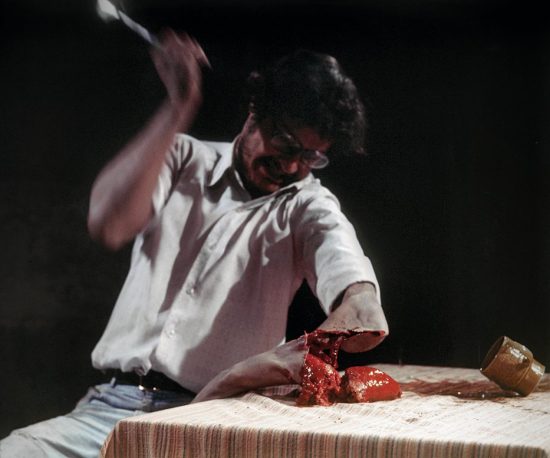Andrew Frost reports from the salt encrusted front lines at the NGA…
There was a moment at the opening of Mike Parr’s career survey exhibition, Foreign Looking, when I began to have grave doubts.
The opening night crowd were pressed into one of the NGA’s downstairs galleries that had been stripped of everything except for Jackson Pollock’s Blue Poles. We were watching Parr, frocked up in a white gown, having makeup applied by a beauty professional. The doubt suddenly flickered in my mind: is this for real? Is this what we’re really here for? This is absurd.
Once the makeup session was over, another woman drew blood from Parr’s arm. This went on for some time. A woman in the crowd fainted, and there was a hubbub as NGA guards came in to see if she was OK. A young artist friend standing next to me went off to the bar and helpfully returned with a salt-encrusted Bloody Mary, my third of the evening. People around us started making jokes – “I hope he gets a cookie when he’s finished”.
Then part three began: Parr, somewhat shaky from having so much blood drawn, was led over to the floor in front of Blue Poles. He lay down and then, for the next five minutes, another assistant took a paint brush, dipped it into a bowl of Parr’s blood, and started slashing it over the artist’s dress.
It was a Pollock, only in blood, and since the famous American abstract expressionist died in a car crash, there was an irony at play.
In the greater scheme of Parr’s performances, this was all fairly laid back; he’s had his lips sewn together on more than one occasion, burnt and punctured his legs, vomited blue dye – all those masculine performance art clichés, but given an urgent and personal meaning in Parr’s oeuvre.
Parr began his career as a conceptual artist, and as you enter the exhibition proper there’s a number of early text works including Facts About The Room (1970): one hundred statements about the room you’re standing in, the first among them stating that this is a room with windows. It actually has no windows, so the narrative that unfurls as you read the statements creates a push-pull between what you read and what you’re actually experiencing, an imaginative transaction between the artist and the viewer.
The links between language and perception, gesture and meaning have been a central tenet of the artist’s work throughout his career. After more than a decade of producing performances and conceptual works, Parr began his Self Portrait Project in the mid-1980s. These etchings produced using power tools such as angle grinders – no mean feat given that Parr was born with only one arm – have become renowned works in their own right within Australian contemporary art. They are an obsessive response to the idea of capturing a representation of the self through drawing, albeit one mediated by a Black and Decker; despite the heavy black lines and lakes of ink, there is a suppleness to them that is remarkable.
The weight of Parr’s Self Portrait Project is apparent in the number of attempts he’s made to end it. He has done performances where he’s painted out his prints in red and black paint, documenting the process on video, and earlier this year he set fire to a pile of his prints at Carriageworks, in a gesture that was somehow meant to protest global warming – how that works I’m not sure.
Meanwhile, his performances over the decades have oscillated between what appear to be exercises in aesthetics, to bloody political protests – including variations on the lip-sewing works – to performances such as those at the opening, where he puts on a dress and does something, like eat an apple.
As a viewer at the NGA, I was reminded of another Parr performance way back in October 1982, one that I’d seen as part of a group of young art students who’d bussed down to Canberra for Act 3, a performance art festival that featured Parr, Stelarc and Dale Frank among others. The specifics of that multi-part, multi-site performance are lost to memory but some details remain: part one was secret; part two involved driving out to Lake Burley Griffin and watching Parr on another dark promontory starting a fire; and part three was spectacular. The audience was ushered into a room lined with uniformed school kids sitting in total silence. In the front of the room, a white chair with a blue lightbulb stood out like some weird robot, and in the background, outside and behind glass, was Parr stoking a huge fire.
Like at the recent NGA performance, I was confronted by the entirely arbitrary nature of meaning in art – the random decisions about how one medium is somehow more worthy than another, how one form has more cultural relevance. What did it all mean? I still can’t tell you, but the poetry of the moment has always stayed with me – and those moments of doubt only last for a second.
This review also appeared here

